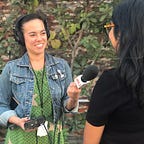5 ways I’m incorporating engagement into everyday reporting
I started covering early childhood education at KPCC-LAist almost four months ago.
Engagement is baked into this role. The station recently redesigned the beat to focus on telling stories with and for parents and caregivers of children 0–5 in Los Angeles.
My interpretation? The job is to help provide information that will ultimately contribute to young children growing and thriving.
I’ve been a reporter for a while now, but in a lot of ways I’m a newbie here. I’ve spent almost my entire professional career reporting in Arizona.
So here are a handful of daily engagement practices I’ve deployed to build up the beat. They may not work for everyone, but so far, they’ve worked well for me!
Talk to the people
I’ve spoken with more than 150 people since I started (more on how I keep track of it all below.)
This includes home daycare providers, policy experts, parents, community leaders, local and state agencies. In addition to learning the basics of who these people are and what they do, I ask questions like:
- What’s an issue that isn’t getting enough attention?
- What do you wish you knew more about?
- How do you find information about early childhood?
Even as I move into more formal interviews for specific stories, I try to tack these questions on to the end of the conversation.
I’m also making time to visit different places where young children receive services, like health clinics, daycares, and preschools.
In the words of former KPCC reporter Michelle Faust Raghavan, “If you want your reporting to help more people, start by identifying the target audience and where they are most likely to be.”
Super spreadsheet
I record all of my sources in a spreadsheet.
In addition to a person’s name, title, and contact information, I include relevant keywords (parent, state government, toddler, special education, etc.) that will help me search for that person in the future as well as a note about what we discussed last time we talked.
I try to update the spreadsheet in real time, but since that doesn’t always happen, it’s helpful to have about 20 minutes a week devoted to the task.
The ‘engaged’ follow-up story
My first big story for KPCC-LAist was on a promising program for African-American moms to-be derailing after accusations of racial insensitivity.
This story built on my predecessor Priska Neely’s important work on black infant mortality. It was through her detailed notes that I found out about the program’s existence in the first place.
In talking with LAist editor Lisa Brenner, we realized before we could get to the heart of the story, we’d have to answer a basic question: What even is a doula?
Knowing that doulas would likely play a role in future stories, we collected audience questions and drew on the expertise of those in the community answer that basic question and more in a digital-first piece that later was adapted for radio.
Close the loop
The smart folks at Hearken talk about audience engagement as a ring. The newsroom invites feedback, the public gives it, and journalists use what they say to inform their stories.
But how does the public find out I used their feedback in my story? Especially if they’re not part of the typical audience?
I tell them.
If I’ve done a public ask for feedback, I make a quick comment back on the social media post with a link to the story.
If I’ve interviewed someone or somehow asked them for information, I refer back to the super spreadsheet so I can send them a link to the story.
I do this even if someone’s quote didn’t make the final cut and include an explanation of how the editing process doesn’t always allow us to include every voice.
I make a point to do this even for stories that aren’t really related to my beat.
In January, I participated in KPCC’s coverage of Kobe Bryant’s death, recording interviews with people who gathered to pay their respects to the Lakers player and his daughter Gianna outside Staples Center.
The next day I sent out an email thanking people for their time, explaining that parts of our interviews had aired throughout the day in the station’s newscasts, and pointing them to my Twitter feed.
One of the people I interviewed turned out to be a marriage and family therapist who had an interesting perspective to share on early childhood and trauma — a topic I’m planning to focus on in future reporting!
Find a friend
I am very fortunate that KPCC has built a collaborator into the early childhood education beat: engagement producer Stefanie Ritoper. Read about her work here.
She’s helped me meet people on the beat, brainstorm stories, connect with the community, and torn me away from my computer to eat mole at amazing L.A. institutions.
But even before I met Stefanie, I was able to do the work I did because I sought out people in the newsroom who could take a few minutes out of the day to talk about how we might approach our work differently and with new enthusiasm.
I’ve learned engagement (like adulthood) is not a trophy earned once and put on a shelf. It’s a daily practice that over time will help me better understand the community I cover and create stories that will serve them.
I’d love to hear how you incorporate engagement into your reporting. I’m on Twitter at @mariana_dale.
